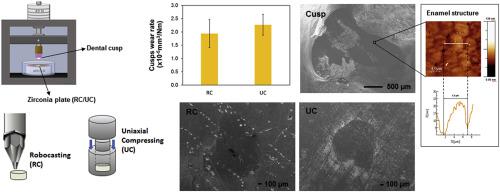Journal of the Mechanical Behavior of Biomedical Materials ( IF 3.3 ) Pub Date : 2020-06-11 , DOI: 10.1016/j.jmbbm.2020.103900 A C Branco 1 , R Silva 2 , H Jorge 3 , T Santos 4 , K Lorenz 5 , M Polido 6 , R Colaço 7 , A P Serro 8 , C G Figueiredo-Pina 9

|
This study aims to evaluate the tribological performance of the pair human teeth/robocasted zirconia, with a special focus on the enamel wear mechanisms. Zirconia pieces produced by robocasting (RC) and unidirectional compression (UC) were compared in terms of crystalline structure, density, porosity, hardness and toughness. Chewing simulation tests were performed against human dental cusps. The cusps wear was quantified and the wear mechanisms identified. Although most of the properties of UC and RC samples are similar, differences were observed for surface roughness and porosity. Although the samples did not suffer wear, the antagonist cusps worn in a similar way. In conclusion, robocasting seems a promising technique to produce customized zirconia dental pieces, namely in what concerns the overall tribological behaviour.
中文翻译:

人类牙齿与 3D 打印氧化锆的摩擦学性能:体外咀嚼模拟研究。
本研究旨在评估人类牙齿/机器铸造氧化锆对的摩擦学性能,特别关注牙釉质磨损机制。对通过机器人铸造(RC)和单向压缩(UC)生产的氧化锆件的晶体结构、密度、孔隙率、硬度和韧性进行了比较。针对人类牙尖进行咀嚼模拟测试。量化尖头磨损并确定磨损机制。尽管 UC 和 RC 样品的大部分性能相似,但在表面粗糙度和孔隙率方面观察到差异。尽管样品没有受到磨损,但拮抗尖头也以类似的方式磨损。总之,机器人铸造似乎是一种生产定制氧化锆牙科件的有前景的技术,即涉及整体摩擦学行为。











































 京公网安备 11010802027423号
京公网安备 11010802027423号